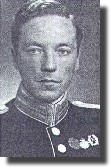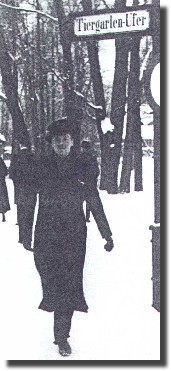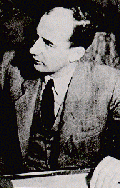PER ANGER
 |
 |
 Per Johan Valentin Anger was born December 7th, 1913 in Gothenburg, Sweden. He studied law
at the University of Stockholm, and then later at the University of Uppsala. After he graduated
in November 1939, the same day as war broke out between the Soviet Union and Finland, Per Anger
was drafted to the army. Shortly thereafter the Ministry of Foreign Affairs offered him a trainee
position at the Swedish legation in Berlin, Germany. Per Anger finished his army service in
January 1940, and by the end of that month he arrived in Berlin. This is where his diplomatic
career began.
Per Johan Valentin Anger was born December 7th, 1913 in Gothenburg, Sweden. He studied law
at the University of Stockholm, and then later at the University of Uppsala. After he graduated
in November 1939, the same day as war broke out between the Soviet Union and Finland, Per Anger
was drafted to the army. Shortly thereafter the Ministry of Foreign Affairs offered him a trainee
position at the Swedish legation in Berlin, Germany. Per Anger finished his army service in
January 1940, and by the end of that month he arrived in Berlin. This is where his diplomatic
career began.
BERLIN 1940-1941
Per Anger was young and inexperienced when he arrived in Berlin in January 1940. World War 2
had been going on for almost five months at this time. He was placed in the trade department
and worked on trade between Sweden and Germany.
 He has told about how he up close witnessed
the large masses fascination over Hitler and his propaganda.
He has told about how he up close witnessed
the large masses fascination over Hitler and his propaganda.
Probably the most dramatic experience of his time in Berlin was when the Swedish legation
had received reliable information from underground movements regarding the Nazi-German attack
on Norway and Denmark. There was uncertainty if Sweden was included in the plan. Per Anger was
now responsible to send the coded telegram to Stockholm. That night he couldn't sleep due to his
thought that he might have made a mistake when he sent the cipher, so that the Foreign
Department couldn't interpret it -- then one would be able to read in future history books
about how "Sweden because of the Swedish attache Per Anger in Berlin were taken by surprise
by a German invasion army!".
Thankfully the message got through as it should though, but the Foreign Department in Sweden
didn't believe these statements and did not inform it's neighboring countries. A few days later
the legation desperately sent a new message to the Foreign Department with information from an
even more reliable source. Now it was taken seriously, and Norway was warned. The Norwegian
foreign minister Kut called for the German military attach and asked his straight forward if
this information was accurate. He of course denied everything. The following day that same
officer took control over entire Oslo.
In June 1941 Anger returned to Stockholm and became an official Swedish diplomat. Between that
time and until March 1942 he worked at the Foreign Department's trade section on the relations
between Sweden and Hungary. The work mostly concerned the import of Hungarian food provisions
in exchange for Swedish steel.
THE LEGATION IN BUDAPEST
June 12th 1942 Per Anger was appointed second secretary at the Swedish legation in Budapest,
Hungary. On November 26th that same year he entered his duties there.
The Swedish legation in Budapest was a very small unit at that time. The equivalent to
ambassador was Minister Carl Ivan Danielsson, and thereafter Per Anger in the order of precedence.
Formally he was the second secretary, but in protocol he acted as first secretary. Further the
legation consisted of D�nes von Mezey who was in charge of administration, Harry Wester who
was the military attach, Margareta Bauer and Birgit Brulin who were secretaries, and finally
the Swedish Red Cross representative in Budapest, Valdemar Langlet.
Per Anger's main work was still Swedish-Hungarian trade. The years from his arrival in Budapest
till the German occupation in 1944, Anger has described as relatively harmonious. There was no
shortage of food, the restaurants were open, and the Gypsies played music in the restaurants, like
before the war. The Jews were discriminated and didn't have the same rights as others, but their
situation was not difficult like it would become after the German invasion.
THE HOLOCAUST
In his book Per Anger describes how reports of liquidation in gas chambers in Poland, one way
or another, already in 1942, had reached Budapest.
March 19th 1944 Germany invaded Hungary. After the German invasion the situation changed
drastically. Per Anger witnessed the Nazi's persecutions and how their "final solution" plans
were put in motion. He was shocked the first day when suddenly every fourth person on the
street was wearing a yellow star of David -- the humiliation, and knowledge of how low
humanity could sink.
In an interview for the magazine "Vi" Per Anger told:
"First then everything was revealed. Mainly by stories from people who managed to escape.
We sent home reports of extermination camps, sketches of the gas chambers in Auschwitz...//...
We became witnesses to what we didn't think was possible: a systematic extermination of
people."
THE RESCUE OPERATION BEGINS
In an interview with Dr. Paul Levine Per Anger speaks about the first days after the occupation:
"The first days we couldn't do so much. I mean, we didn't know what was going to happen. We
understood that now would be a hard time for the Jewish population and it (the persecutions)
started just a few days later. So then we were forced to mobilize our powers. From that moment
everything that had to do with trade with Sweden or other routine errands were of course put
aside, and we concentrated... the whole legation concentrated on one thing. To save... try to
save human lives."
Jews with relatives or business associates in Sweden started to line up in front of the Swedish
legation to ask for help. Per Anger came up with the idea to issue provisional passports. The
passport was in fact a kind of travel document which was given to Swedish citizens abroad whom
had lost their real passports. Minister Danielsson gave his approval for them, but said that
Per Anger would take responsibility for them. Afterwards the Swedish Foreign Department also
came to approve the passports. D�nes von Mezey managed through his contacts with the Hungarian
authorities to negotiate that the bearer of such a passport would be respected as a Swedish
citizen, and that this person would need to wear the yellow star of David. This way interment
and deportation would be avoided.
Per Anger also came up with the idea to issue special certificates to the many Jews who had
applied for Swedish citizenship. More than 700 provisional passports and certificates were
issued at first, and the rumor started to spread among the Jews of Budapest. The documents
completely lacked any form of legality in international law.
RAOUL WALLENBERG'S ARRIVAL IN BUDAPEST
The Swedish legation acted on behalf of seven countries in Hungary at this time. Simultaneously
the stream of people seeking help from the Swedes increased. This brought about the legation's
 request for reinforcements. At the same time negotiations were taking place between the
American War Refugee Board, the Swedish Foreign Department and the World Jewish Congress
regarding sending a person to Hungary with a mission to lead the rescue of Hungary's Jews.
request for reinforcements. At the same time negotiations were taking place between the
American War Refugee Board, the Swedish Foreign Department and the World Jewish Congress
regarding sending a person to Hungary with a mission to lead the rescue of Hungary's Jews.
It was Raoul Wallenberg who was
appointed to be this person.
He was given the status of legation secretary in Budapest and arrived there July 9th 1944.
Wallenberg looked at the old documents and then presented the idea of a new document he thought
would be more effective; the protective passes - Schutzpasse. Wallenberg was well aware of how
flashy papers printed in color with signatures, seals and stamps impressed the Germans. The
result was a document printed in yellow and blue with the "Tre Kronor" - three crowns from the
Swedish state symbol - and the signature of the Minister. Once again, these documents had no
legal support what so ever, but Germans as well as Hungarians came to respect them.
In August 1944 Per Anger traveled to Stockholm to request even more reinforcements for the
legation. The new people came to be the attache Lars Berg the administrator G�te Carlsson,
and the Swedish "Save The Children" representative Asta Nilsson. Consul Yngve Ekmark was also
tied to the legation and organized storage and distribution of food, medicine and clothing
for the rescue operation.
AT THE TRAIN STATION
In an interview with the Los Angeles Times Per Anger was asked if he ever partook in the direct
rescue of Jews. He answered that he sometimes received calls from Wallenberg who asked him to
go to the train station to save people from the deportations when he was hindered to do it
himself. This is how Anger described one of those situations:
"When Wallenberg one day was somewhere else, I went to a station from where a train with
Jews was about to depart. There was no time to be diplomatic with the Germans. I explained
that a terrible mistake had been done because they apparently were on their way to deport Jews
with Swedish protective passes. If they weren't released immediately I would see to it that
Veesenmayer was notified. The German train commander didn't dare risking being reported to
the feared Veesenmayer. I went in to the wagons to call for names, but only found two Jews with
protective passes. With the help of the present Hungarian police officer, Batizfalvy, who in
secrecy worked in cooperation with Raoul Wallenberg and me, I succeeded, in defiance of the
SS commanders order, to leave the station with 150 Jews towards freedom, 148 of them without
protective passes."
ALONG THE DEATH MARCHES
On November 10th 1944 the Russians and Americans bombed the Hungarian rail roads and made train
deportations to Auschwitz impossible. Adolf Eichmann then suggests to let the Jews in Budapest
march 180 kilometers by foot to the Hungarian-Austrian border station at Hegyeshalom.
Possession of protective passes didn't help this time. Per Anger describes in his book how
"thousands of people were taken as they walked and stood".
Raoul Wallenberg, Per Anger, and the legations of other neutral countries reacted quickly.
In his book Anger describes one of their car trips along the death marches:
"One of the first days in December 1944 Wallenberg and I took a car ride along the road the Jews
marching on. We passed these crowds of miserable people, more dead than alive. With gray faces
they staggered forward under chops and hits from the soldier's rifles. The road was lined by
dead bodies. We had our car filled with food that we managed to distribute in spite of
prohibitions, but it didn't last very long. At Hegyeshalom we saw how the ones who arrived
were handed over to a German SS commando under Eichmann, who counted them like cattle.
'489 - correct' ('vierhundertneunundachtzig - stimmt gut!'). The Hungarian officer received
a receipt that everything was in order.
Before this handing over we managed to save some hundreds of Jews. Some had Swedish protective
passes, others were gotten out by pure bluffing. Wallenberg didn't give up and made renewed
journeys when he in similar ways managed to reunite some additional Jews with Budapest."
The death marches to Hegyeshalom ended on December 10th 1944. At that time 37000 Jews had been
put on march from Budapest - 27000 arrived at the border station.
THE SOVIETS ARRIVE, AND THE WAR ENDS
When the Soviet troops seriously got closer to Budapest, the Swedish legation was offered to
leave the country by the Foreign Department due to the large risks. In spite of bombs and
grenades falling over their heads, and that their lives were threatened by the Arrow Cross,
everyone remained in Budapest, except one of the women who was persuaded to go home. They knew
that if they'd leave the country their proteges wouldn't stand a chance and all rescue work
would have been in vain. There was no other guarantee for their safety.
From now on and till the Soviet army's entry in Budapest, one lived in constant threat for life.
Life was spent more under ground now in shelters, than above. Dispersed over different places
in the city the Swedes quickly lost contact with each other. After the Russians entry everyone
found each other again though, except for Raoul Wallenberg.
The last time Per Anger met Wallenberg was January 10th 1945. He had then asked Wallenberg
to cancel his operation and stay in the Buda-side of the city, otherwise his life we be in
great danger. Wallenberg refused to interrupt his work. On January 17th 1945 Raoul Wallenberg
was taken away by the Russians and his destiny is a mystery till this day.
The members of the Swedish legation were put in Soviet "custody" over some period, until order
of their return home came from Moscow. April 18th 1945 the Swedish legation from Budapest
arrived in Stockholm. This ended the "Budapest adventure" for secretary Per Anger.
SUMMARY
The war was over, but now Per Anger's search for Wallenberg started. He has been one of the
foreground figures in this search throughout the years, and he has also helped spread
information about Wallenberg's deeds all over the world.
After Budapest he continued his
diplomatic career
where he, before his retirement, among other places, acted as Sweden's ambassador to Australia
and Canada.
In 1989, as an example of Ambassador Anger's efforts, he urged the German Chancellor Helmut Kohl to intervene in the
Wallenberg affair. Holding an extension phone, Anger listened as Kohl called Mikhail Gorbachev
and pleaded "let that old man go." The Russian had no answer, says Anger, who then went
to Moscow to appeal personally to the Soviet leader: "He showed no interest" and
"implied that he had no control over the KGB."
Per Anger has received several awards throughout the years. He was awarded as a "Righteous Among the Nations" by the State of Israel and Yad Vashem in 1982, an award given to gentiles who with danger for their own lives rescued Jews during World War 2. He has a tree planted in his honor in "The Avenue of the Righteous" in Jerusalem. In November 1995 he was honored with the Hungarian Republic's order of merit which was handed to him by the Hungarian president Arp�d G�ncz. In September 1996 he was honored by the Jewish Council of Sweden.
In 1997 the only book about Per Anger was published, "A Quiet Courage -- Per Anger, Wallenberg's Co-Liberator of Hungarian Jews". The book was written by Elisabeth R Skoglund and published by Baker Books.
Since then Anger has been rewarded in many more ways for his work. Among the most noteworthy was when he received honorary citizenship in Israel in 2000, and the Illis quorum medal in gold in the spring of 2002, awarded to him by the Swedish government for his work during World War Two as well as his struggle for knowledge on the fate of Wallenberg.Per Anger spent his final years living half of the year in Sweden and the other half in France.
Per Anger passed away in Stockholm on August 26, 2002, with his family by his side.